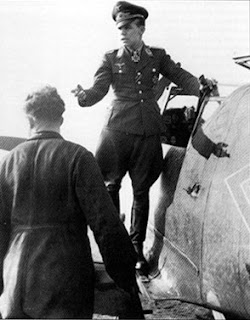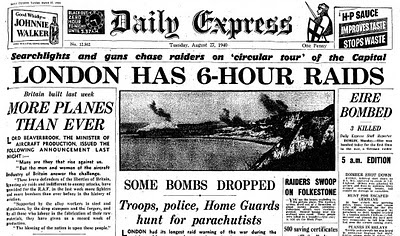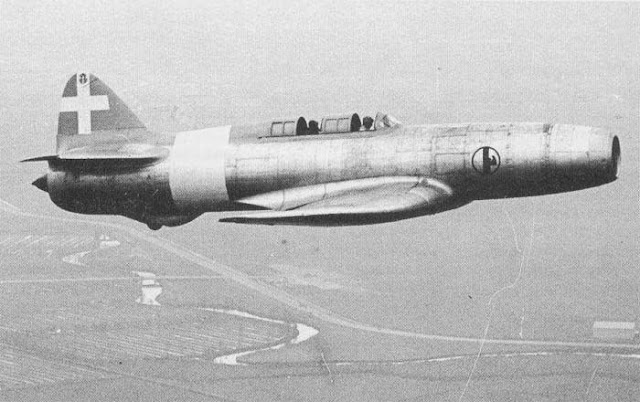Tuesday 27 August 1940
 |
| Polish aviators in England, with a light day due to poor weather, exercise (IWM). |
Early in the morning just after midnight, Gillingham is hit hard, with its bus depot, fire station and several other structures destroyed or heavily damaged. There are 20 killed and 40 injured.
Around noontime, a large formation approaches from Cherbourg. RAF No. 10 Group sends up a couple of squadrons to chase them off, with each side losing a plane.
Toward the evening, Dornier Do 17s raid the southwest area, and No. 10 Group sends up three squadrons. The RAF downs three bombers and disrupts the attack. Another raid around midnight on the Bristol area results in some small-scale damage.
Ireland receives some bombs again at Port Clarence in County Durham.
The Luftwaffe raids Scapa Flow during the evening, interrupting Home Fleet operations for a few hours.
Royal Navy armed 23 ton yacht HMY White Fox II catches fire and sinks after being bombed by the Luftwaffe at Plymouth.
Freighter Sir John Hawkins is hit by the Luftwaffe and damaged at Plymouth.
The RAF shuttles units around, sending RAF No. 603 Squadron to Hornchurch, No. 65 Squadron to Turnhouse, No. 32 Squadron to Acklington and No. 79 Squadron to Biggin Hill.
The Luftwaffe awards the Ritterkreuz (Knight's Cross of the Iron Cross) to Oblt. Helmut Wick of JG 2. He has 20 victories.
 |
| Oberleutnant Helmut Wick. |
German Military: Contrary to many media accounts, the Luftwaffe has not been ordered at this point to bomb London, and it does not do so today. In fact, Hitler has not issued any orders on terror bombing, a decision he expressly reserved to himself in his mid-July Fuhrer Directive. Conceivably, the tit-for-tat raids on London and Berlin may still turn into one-offs.
Another proposed operation, Operation Felix, receives a blow when Abwehr chief Admiral Canaris returns from Madrid with a pessimistic outlook. He tells OKH Chief of Staff Franz Halder that the operation depends upon a completely unreliable potential ally. During their meeting, Spanish General Juan Vigón Suerodíaz had made the discouraging request for Germany to supply food and fuel because the Spanish food situation was deteriorating. Franco, Canaris reports, is steadily losing domestic support. Canaris tells Halder that Spain would be "unpredictable" and concludes:
We shall get an ally who will cost us dearly.Operation Felix remains alive within the planning process, but, like Operation Sea Lion, it is growing more and more unlikely.
 |
| Sergeant Jack Stokoe transfers today with the rest of his No. 603 Squadron to RAF Hornchurch. Stokoe is a pre-war auxiliary pilot now in the thick of it. |
U-28 (Kptlt. Günter Kuhnke) torpedoes and damages 1599 ton Norwegian freighter Eva west of the Outer Hebrides. There are 17 survivors and one man perishes. The Eva remains afloat due to her timber cargo, and it takes two torpedoes and the deck gun to reduce it to a blazing wreck. It still stays afloat long enough to come ashore at the Butt of Lewis, a total loss. Eva is a straggler due to reduced speed resulting from bad coal. The RAF shows up and interrupts U-28's attempts to help the survivors.
U-37 (Kapitänleutnant Victor Oehrn), on its seventh patrol and operating out of Lorient, uses gunfire to sink 3409 ton Greek maize freighter Theodoros T. southwest of Ireland. Everybody aboard survives.
Convoy FN 264 departs from Southend, Convoy MT 152 departs from Methil, Convoy FS 264 departs from the Tyne, Convoy OB 204 departs from Liverpool.
Troop Convoy US 4 departs from Auckland, New Zealand. It has three troopships and is under escort.
Battle of the Mediterranean: The RAF bombs Derna.
Island commander Governor Dobbie receives a telegram from Whitehall telling him that Malta will receive numerous additional anti-aircraft guns during the winter. However, Dobbie has to recruit people to man some of the guns and there are not a lot of people available.
 |
| German auxiliary cruiser Pinguin, identification number Schiff 33 (HSK 5). The Royal Navy called her "Raider F." |
Later, the Pinguin captures Norwegian freighter Morviken. After boarding the crew and making them POWs, the Pinguin sinks the Morviken.
Pinguin then takes the trailing 7616 Norwegian ton tanker Filefjell south, away from the shipping lanes, to take aboard its 500 tons of fuel oil. It then sinks the tanker (which still has large quantities of oil products) with its deck guns, causing a huge explosion and fireball.
Separately, Panamanian freighter Bolivar takes on the water without any external factors involved and sinks. Everybody survives.
German/Hungarian/Romanian Relations: Hitler requests a meeting in Vienna with Hungarian and Romanian representatives regarding their border dispute. Tensions remain high as Romania continues to maintain that Hungarian aircraft have violated its airspace. Hungary claims the same, and also claims to have shot down a Romanian bomber. There is no proof that anyone actually was violating anyone's airspace.
Free France: Charles de Gaulle's Free France movement receives a much-needed boost in Africa thanks to, among others, Captain Leclerc. About forty men have launched a coup in Cameroon against the Vichy colonial government. Today, Leclerc, Claude Hettier de Boislambert and a few others leave Victoria, British Cameroon in native canoes (pirogue) bound for Douala, Cameroon, where they occupy the Vichy Government Palace without opposition.
US Government: President Roosevelt signs a law authorizing him to call up Army Reserves and National Guard units for one year of service. Other legislation authorizing him to call up US Navy and US Marine Corps reserve aviators also is in the works. The legislation allows for the appointment of reserve aviators to become regular pilots.
The destroyers-for-bases deal faces some opposition in Congress, but Roosevelt has his people continue with the preparations. Admiral Stark certifies that the destroyers are not necessary to protect US shores. Attorney General Robert H. Jackson certifies the sale as legal under US law.
Iceland: RAF Coastal Command establishes its first airbase to protect the sea lanes. This is becoming urgent because the U-boats operating out of French ports now can reach out into the middle of the Atlantic. The first patrols use obsolete Fairey Battles. The patrols are only as good as the aircraft used, and the increasing range of operation of RAF (and later USAAF) aircraft is destined to have a major influence on the Battle of the Atlantic.
Canada: Troop Convoy TC 7 departs from Halifax under heavy escort. It includes six troop transport ships each carrying between 1153-2801 Canadian troops.
All single Canadian men 21-45 become subject to the military call-up.
 |
| Downed Luftwaffe planes accumulated in a giant scrap heap in England. 27 August 1940. (AP Photo). |
August 1, 1940: Two RN Subs Lost
August 2, 1940: Operation Hurry
August 3, 1940: Italians Attack British Somaliland
August 4, 1940: Dueling Legends in the US
August 5, 1940: First Plan for Barbarossa
August 6, 1940: Wipe Out The RAF
August 7, 1940: Burning Oil Plants
August 8, 1940: True Start of Battle of Britain
August 9, 1940: Aufbau Ost
August 10, 1940: Romania Clamps Down On Jews
August 11, 1940: Huge Aerial Losses
August 12, 1940: Attacks on Radar
August 13, 1940: Adler Tag
August 14, 1940: Sir Henry's Mission
August 15, 1940: Luftwaffe's Black Thursday
August 16, 1940: Wolfpack Time
August 17, 1940: Blockade of Britain
August 18, 1940: The Hardest Day
August 19, 1940: Enter The Zero
August 20, 1940: So Much Owed By So Many
August 21, 1940: Anglo Saxon Incident
August 22, 1940: Hellfire Corner
August 23, 1940: Seaplanes Attack
August 24, 1940: Slippery Slope
August 25, 1940: RAF Bombs Berlin
August 26, 1940: Troops Moved for Barbarossa
August 27, 1940: Air Base in Iceland
August 28, 1940: Call Me Meyer
August 29, 1940: Schepke's Big Day
August 30, 1940: RAF's Bad Day
August 31, 1940: Texel Disaster
2020


No comments:
Post a Comment